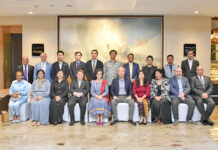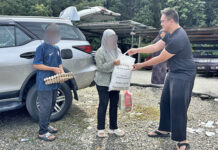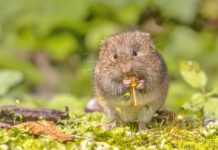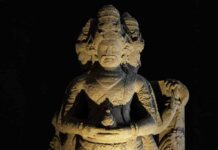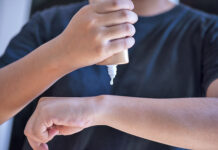At a sharp bend in Jalan Lamunin, Tutong District, there’s a tree growing where it isn’t supposed to be, bearing fruit that is increasingly rare in the Sultanate – a rainforest nut called the pelajau.
“I remember growing up with the tree as a kid. It grew up alongside me, but I never knew what kind it was until it bore fruit this year,” said 54-year-old Ariffin, whose backyard has become the site of this rare find.
Rare, at least in Brunei Darussalam, though well-documented and beloved by our neighbours in Sarawak.
Scientifically known as pentaspadon motleyi, it’s a medium-to-large tree that can reach up to 50 metres tall and 70 centimetres in diameter, often found along alluvial floodplains and riverbanks throughout Borneo, especially in lowland Sarawak.
More broadly, the pelajau can be found across Southeast Asia – from Malaysia and Indonesia to New Guinea and the Solomon Islands. It is often harvested from the wild, mainly for local use as food, medicine, and a source of wood.
In the Land of the Hornbills, it goes by many names, including buah empit, often sold in local markets in December.
Though common in certain areas of Borneo, it is worth noting that the species faces significant threats from habitat destruction in New Guinea and the Solomon Islands, where it is considered endangered. The situation is likely similar elsewhere.
The plant is classified as ‘Data Deficient’ in the International Union for Conservation of Nature Red List of Threatened Species (2013), meaning there is insufficient information to properly assess its conservation status.




The almond-like kernels of the pelajau are popular in both Iban and Chinese cooking in Sarawak. The edible seeds are surrounded by a corky pericarp, which makes the fruit excellent floaters.
Even the Dusuns of Mukim Lamunin, who are familiar with the fruit, found it strange to see the pelajau behind Ariffin’s backyard. The elders of the community have always said that the pelajau only grows near rivers, and where this one is growing, there is none.
“The tree is almost, if not older, than me. There must’ve been a river flowing through here once upon a time,” Ariffin added.
SOMETIMES, THE FOOD WE EAT REFLECTS THE CULTURE OF A PLACE
Some recipes using the pelajau are savoury. For example, some Sarawakian natives stir-fry tempoyak – a traditional Southeast Asian condiment made from fermented durian – while adding pelajau. There are also recipes of Sarawakian Chinese cooking the nuts in soup with meat.
Meanwhile, here in the Sultanate, the pelajau is often used in desserts, often being added in the traditional bubur kacang – a traditional dessert made from mung beans (kacang hijau), cooked in coconut milk and sweetened with palm sugar or regular sugar.
According to Eyon Ukoi, who runs a farm-to-table initiative in Tutong District focused on preserving ethnic heritage recipes, the pelajau, like the meritus or mitus fruits that have been featured, is part of a group of fruits the Dusun of Lamunin refer to as buah besar.
Dusun elders have long claimed that a bountiful fruiting season follows whenever the pelajau appears.
“Our elders seemed to have gained knowledge by observing nature. The pelajau is a wild rainforest nut, but they used it as a kind of benchmark to predict the harvest for that particular season,” Eyon explained.
For individuals like Eyon, who are dedicated to preserving heritage recipes, this also means protecting the ingredients tied to those traditions, like the pelajau, which is rarely seen in local markets today. For her, it’s not just about preserving a culinary legacy – it’s about maintaining ancestral knowledge as well.
“The ethnic communities of the past had vast knowledge of foraging. When it came to fruits like the pelajau, they would often observe animals to determine if the plant was safe to eat.
“If a bird could eat it without harm, they believed it was safe for us too. That’s what we were taught,” she added.
SOMETIMES, THE FOOD WE EAT REFLECTS THE HEART OF A COMMUNITY
The pelajau, when it fruits, does so in heavy abundance, making its preparation and peeling a public affair requiring as many hands as possible.
Due to the corky and fibrous shell that encases the edible seeds, peeling by hand can be taxing on the fingers – especially when you’re dealing with multiple gunny sacks.
Ariffin, proudly recounting the long-unused machine that has been stuck in a tree for who knows how long, said, “We used to use an old rubber sheet roller machine – originally designed to process natural rubber into sheets.
“We would pour all the pelajau through the heavy rollers to squeeze out the kernels.”
Another unidentified fruit tree has grown through the traditional rubber processing machine, keeping it in place in a meld of metal and wood.
“If you peel enough of the fruit, you really understand the strain that comes from it,” he added.
“Plus, it was always a community event – one person would feed the fruit through the rollers while another cranked them manually.”
Another elderly woman from the Dusun community in Lamunin, who was also present, showcased one of her bent fingers – an injury caused by peeling pelajau using a similar rubber processing machine.
She displayed the injury with a smile, seemingly unfazed by how it had altered her hands.
For her, the memory was all about her family coming together to peel the pelajau.
For the Dusun community, these shared memories of harvesting, peeling, and enjoying the pelajau evoke a deep nostalgia for simpler times – an era of foraging and subsistence.
It serves as a reminder of traditions that have gradually faded, much like the rare fruit itself, urging them to hold on to what remains of their cultural heritage before it disappears entirely. – Wardi Wasil



